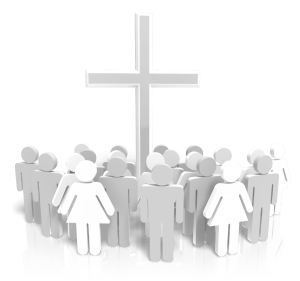
I delivered the following message at Calvary Baptist Church of York, Pennsylvania, at its Sunday morning worship service, on January 17, 2021. This post is the first of a series of posts presenting my notes and visuals that I used in the presentation. The title of the sermon is Four Chairs.
However, it begins by pointing you to the cross and asking you two questions. Firstly, “When you look at the cross, what do you see?” Secondly, “How do you view yourself in relationship to the Cross?”

As a teacher, I prepared this lesson using the same simple three-point plan shown in Slide 1 to the left. I have used this guide in all the lessons I have taught over many years.
The purpose of teaching is to help students learn and apply what they learned. It is not to showcase what the teacher knows or has learned. Good instructors must make a difference in students’ thoughts and lives. Otherwise, they are not good, effective teachers.

My two challenging questions for today’s lesson are 1) What’s your view of the cross? 2) Where do you stand with God? This is illustrated in the slide to the right.
Why am I focusing on the Cross when the title of my message is Four Chairs? The title of the slide tells the whole story. I am asking you today to consider life’s two most important questions. I will be using four chairs as props as I invite you to carefully consider where you stand or sit in God’s eyes.
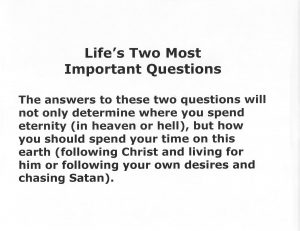
If I were in your seat, I would be asking, “Why are those two life’s most important questions?” I believe the slide to the left answers that question.
Do you know where you will spend eternity? Is it in heaven with God? In John 14:6, Jesus said,
“I am the way the truth and the life. No one comes to the Father except through me.”
If heaven is not your final destination, what then? John 3:18 tells us,
“He that believeth on Him is not condemned: but he that believeth not is condemned already, because he hath not believed in the name of the only begotten Son of God.”
These questions are important because they also should determine how we live our lives today on earth. Paul, writing to the church in Philippi, says,
“If by any means I might attain unto the resurrection of the dead. Not as though I had already attained, either were already perfect: but I follow after, if that I may apprehend that for which also I am apprehended of Christ Jesus. Brethren I count not myself to have apprehended: But this one thing I do, forgetting those things which are behind, and reaching forth unto those things which are before, I press toward the mark for the prize of the high calling of God in Christ Jesus.” (Philippians 3:11-14, KJV)
If you are not following Christ, you are following the devil. Speaking to the Pharisees in John 8:44, Jesus forcefully stated,
“Ye are of your father the devil, and the lusts of your father ye will do.”
Thus, there are only two possible paths. You are either heading toward heaven and following Jesus, or your heading to hell and following the devil.
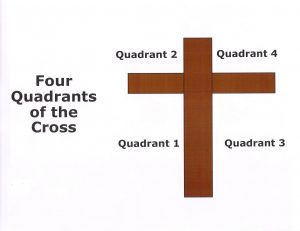
If the cross is so important, let’s take a closer look at it. If you look closely at the cross on the sanctuary’s front wall, you will see a vertical timber and a horizontal one.
I see a set of perpendicular axes that divide the sanctuary’s front wall into four distinct parts or quadrants from many years of working in mathematics. I have numbered the quadrants in the slide on the right.
Now, forget about the choir loft’s back wall and focus on the cross. To set the stage, the image below shows the sanctuary of CBC with the cross clearly visible.

If you can, visualize a very bright, white light above and behind the cross. Such a light would create a giant shadow on the floor of the sanctuary.
As I see it in my mind, the vertical timber shadow would pass across the pulpit and down the sanctuary center aisle. The shadow of the horizontal timber would be perpendicular to the shadow of the vertical timber.
I imagine it crossing the sanctuary’s floor at the steps up to the platform and choir loft. Thus, the shadow of the cross has divided the sanctuary into four quadrants. I have strategically placed one chair in each of these four quadrants. As I proceed with this message, I will explain what these four quadrants and chairs represent.

Let’s turn our attention back to the cross. Throughout modern history, the cross has been recognized as a great dividing line. We can think of the vertical timber as a dividing line of history. Time has traditionally been measured as BC (Before Christ), and AD (No! it doesn’t mean after death. It stands for the Latin phrase Anno Domini, which means the Year of our Lord.) Humanity’s timeline is pictured in Slide 5 to the left.
Since our modern society wants to eliminate all references to God and Christ, there is now a movement to use abbreviations CE and BCE in the human timeline. These stand for Common Era and Before the Common Era. However, because our dating and current calendar systems have been in use for the better part of two millenniums, the numbering of years has been kept the same. Thus, according to the modern calendar, we are in the year 2021 CE.
In most mathematical settings, as we look at a piece of paper, chalkboard, or in the modern classroom, a whiteboard or computer screen, we normally think of a timeline or a number line as starting on the left with the smaller numbers and increasing as we proceed to the right.
The cross is the centerline for human history. Looking at the cross, we consider the time to the left before Christ, i.e., BC. Time to the right of the cross is After Christ, i.e., AD.
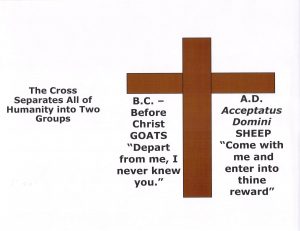
However, in addition to dividing the human timeline, the cross also divides humanity into two groups. On one side of the cross, we have people who have not accepted God’s offer of salvation through Christ’s death on the cross and His resurrection. While on the other side of the cross, we have Christians who believed in Christ and are saved.
Analogously to the human timeline, people to the left of the cross can be labeled People BC: Before Christ. People to the right of the cross are People AD. We can call these people “Acceptatus Domini” or “Accepted of the Lord.”
This phrase reminds me of the greeting that the Apostle Paul used to greet the Christians in Ephesus in the opening of his letter to the Church of Ephesus:
“Blessed be the God and Father of our Lord Jesus Christ, who hath blessed us with all spiritual blessings in heavenly places in Christ…To the praise of the glory of His grace, wherein He hath made us accepted in the beloved…” (Ephesians 1:3-6. KJV)
Another version of this scene is painted for us in Matthew 25 by Jesus as He instructed His disciples in the last week before His Passion. Beginning in verse 31, we read:
“When the Son of Man shall come in His glory, and all the holy angels with Him, then shall He sit upon the throne of His glory:“
Visualize with me, if you will, the Throne of Glory in the balcony today, with Christ looking down at the cross and the congregation. What happens next?
“And before Him shall be gathered all nations: and He shall separate them one from another, as a shepherd divides his sheep from the goats: And He shall set the sheep on His right hand, but the goats on the left. Then shall the King say unto them on His right hand,’Come, ye blessed of my Father, inherit the kingdom prepard for you from the foundation of the world…Then shall He say also unto them on the left hand, depart from me, ye cursed, into everlasting fire, prepared for the devil and his angels…and these shall go away into everlasting punishment: but the righteous into life eternal.” (Matthew 25: 31-34, KJV)
This division of humanity is depicted in Slide 6. This day will be a scene of joy for some and ultimate sorrow for others. Thus, we can view the vertical timber of our cross as the point of a decision to commit to Christ as one’s Savior. These sheep are saved from the penalty of sin. I’m using the props here as an illustration. I am not saying all the people on the left side of the sanctuary are not Christians. It is a pictorial aid.
However, the one question each of us needs to ask ourselves is, “On what side of the cross am I sitting?”
What about the horizontal timber of the cross? What does it represent? To answer that question, I turn to one of the leading psychologists of the mid-20th century, James Marcia. Marcia is most well-known for his theory of identity status.
Marica divided people into four groups according to their answers to two questions:
- Have you as an individual committed to a given value? In our case, today, have you accepted Christ as your Saviour?
- Have you critically examined any alternative to the value(s) you espouse or claim? Have you really studied and understood what your commitment to that value means? Can you explain your value to another individual?
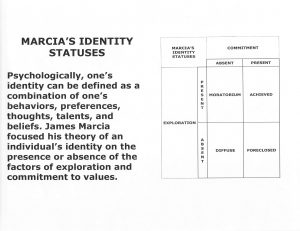
Suppose we were to think of the horizontal timber of the cross as representing Marcia’s second question. The people below the bar have not carefully examined nor studied what committing to Christ means, while the people above the bar have fully considered what such a choice would mean for them. Thus, we have four groups, which are shown in Slide 7.
In the diagram in the right-hand window of the slide, a cross is clearly visible. I hope that you can see where I’m going with this line of thought.

Slide 8 takes us back to the cross. It reviews what the timbers of the cross represent in terms of Marcia’s Christian Identity Status.
Since I surpassed the 2000 word mark in this post, I will wrap it up for today. I will continue my message from this point in my next post, which I plan to publish this coming Tuesday.
If you have any questions or would like to talk, please leave a note in the Comments Section with your contact information. You may rest assured that I share that information with no one else. It will only be used to contact you. Until Tuesday, God bless. Stay safe and well.